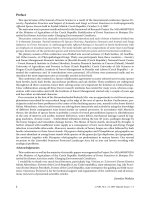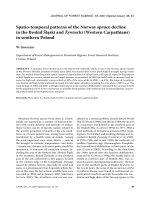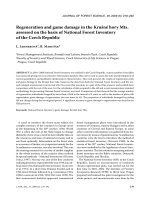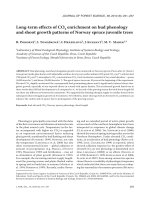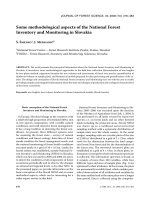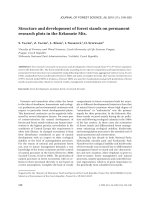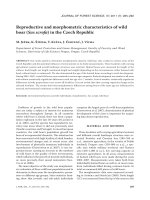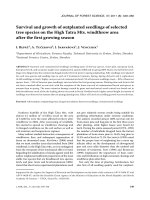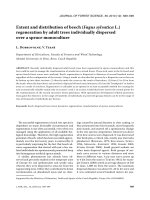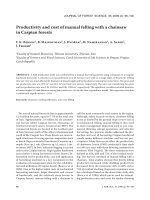Báo cáo lâm nghiệp: "Survival and growth of outplanted seedlings of selected tree species on the High Tatra Mts. windthrow area after the first growing season" pps
Bạn đang xem bản rút gọn của tài liệu. Xem và tải ngay bản đầy đủ của tài liệu tại đây (324.46 KB, 10 trang )
J. FOR. SCI., 57, 2011 (8): 349–358 349
JOURNAL OF FOREST SCIENCE, 57, 2011 (8): 349–358
Survival and growth of outplanted seedlings of selected
tree species on the High Tatra Mts. windthrow area
afterthe first growing season
I. R
1
, A. T
2
, I. S
1
, J. V
1
1
Department of Silviculture, Forestry Faculty, Technical University in Zvolen, Zvolen, Slovakia
2
National Forestry Centre, Zvolen, Slovakia
ABSTRACT: Bareroot and containerized seedlings (seedling type) of Norway spruce, Scots pine, European larch,
European beech, and sycamore maple were outplanted in autumn 2008 and in spring 2009. Roots of a half of the seed-
lings were dipped into the commercial fungal product Ectovit prior to spring outplanting. Fifty seedlings were planted
for each tree species and seedling type in each of 3 treatments (Autumn, Spring, Spring+Ectovit) and 3 replications
(4,500 seedlings in total). Eighty-one per cent of containerized and 75% of bareroot seedlings (most – 89% of bareroot
spruce, least – 59% of bareroot pine seedlings) survived after the first growing season. Planting time and Ectovit did
not have a marked effect on survival, with the exception of the lower survival of containerized beech and spruce in
autumn than in spring. The most extensive damage caused by game and mechanical weed control was found out in
both broadleaves; most of the dry leading shoots occurred in beech. Besides beech, higher annual height increment of
seedlings was observed in autumn than in spring planting time. Effect of Ectovit on seedling growth was not obvious.
Keyword: reforestation; outplanting time; fungal inoculation; bareroot seedlings; containerized seedlings
Southern foothills of the High Tatra Mts. with
almost 2.5 million m
3
of fallen wood on the area
of 12,600 ha were the most affected territory after
windthrow in 2004. After processing of windfalls,
fire started to spread on windthrow clearings and
it changed conditions on the soil surface as well as
soil moisture and temperature regimes.
Many authors studied destructive consequences of
windthrows, fires, and subsequent regeneration of
forest on devastated areas. K (2008) noted
that we must consider areas that resulted from 2004
windbreak in the High Tatra Mts. as very endangered
from the viewpoint of the mechanical effect of wind.
Regarding the stabilization of stands against wind the
author emphasised sufficient proportions of the most
stable tree species that are broadleaved tree species,
larch, and pine. S and S (2001)
stated that short-term experimental plantations need
not give relatively serious results being suitable for
predicting reforestation under extreme conditions.
e authors recorded almost 100% survival rate for
Swiss stone pine and bog pine in the first three years
after planting, while higher losses were found for
larch. During the entire assessed period (1975–1995)
the number of individuals dropped from the former
plantation of Swiss stone pine to 15.6%, bog pine to
32.5% and of larch to 71.5%. B (1993) noted
that the proper time of outplanting has a more sig-
nificant effect on the development of aboveground
part and root collar diameter than the method and
intensity of treatment. F (1996) and R
(1998) emphasised the importance of basic nutri-
ents and fertilization on high-mountain clearings and
windthrow plots after fires.
Not only the time of planting, fertilization, but
also first of all seedling quality used for outplant-
Supported by the Agency for Support of Research and Development on the basis of the contracts APVV-0456-07 and
APVV-0628-07, and by the Scientific Grant Agency of the Ministry of Education of the Slovak Republic and Slovak
Academy of Sciences – VEGA, Grant No. 1/0516/09.
350 J. FOR. SCI., 57, 2011 (8): 349–358
ing is a decisive factor of good adaptation and sub-
sequent survival of plantations (T 2006).
J (2006) reported that shortcomings in
reforestation and necessity of repeated reforesta-
tion are caused by using low-quality planting stock,
neglecting site conditions, insufficient soil prepara-
tion, outplanting of a low amount of seedlings and
insufficient protection of plantations. J and
M (2000) presented the results of culti-
vation of Norway spruce from seed in the 8
th
altitu-
dinal vegetation zone grown in two different nurs-
eries. e results showed that longer cultivation of
planting stock in so-called acclimation nurseries
was not suitable. Individuals from such nurseries
had smaller heights than those from nurseries at
lower altitudes where seedlings had better qualita-
tive and quantitative characteristics.
Š (2009) described the state of revitalization
of an area in the High Tatra Mts. damaged by wind.
Regarding the tree species composition, spruce
accounts for the highest proportion in stands. He
found out by means of monitoring the terrestrial
network that in the numbers of individuals there
were not any differences between salvage clearing
and undamaged well-preserved stands. Most indi-
viduals were from natural regeneration, and only
few individuals were from artificial regeneration,
which accounts for a very low proportion in total
regeneration. Good results were recorded in the re-
forestation of windthrow clearings in state forests
of TANAP by sowing (T 2009). Eleven
tree species were sown to so-called vegetation cells,
in which also hydroabsorbents formed a part of the
substrate. e author considered this way of regen-
eration of salvage clearings as progressive in the
situation when there was an insufficient amount of
high-quality seedlings for windthrow sites.
e objective of this study was to assess the effect
of planting time and application of the commercial
mycorrhizal product Ectovit, containing symbiotic
fungi, on survival, damage and growth of bareroot
and containerized planting stock of some forest
tree species in the first growing season after out-
planting on windthrow and subsequently burned
area in the High Tatra Mts.
MATERIAL AND METHODS
e research planting plot was established on a
clearing where wood was processed after windthrow
in 2004 and fire in 2005. e dominant soil type of
the locality is modal heavily acidic Cambisol, while
the parent rock is moraine and polygenetic debris.
e soil is formed of stones and even of boulders in
some places. e tree species composition before
the windthrow was Norway spruce 70% and Euro-
pean larch 30%; the average age of the stand was
80 years, the typological unit of the site according
to Slovak classification is Lariceto-Piceetum (larch-
spruce stands). Currently, a very sparse mature
stand of larch (age above 140 years) is growing on
the plot. is stand is a certified stand for the col-
lection of reproductive material and it is a part of
gene reserve forests. Norway spruce undergrowth,
rarely Scots pine andEuropean mountain ash (Sor-
bus aucuparia) individuals also occur locally on the
site. e herbaceous cover of the experimental plot
is formed mostly of Chamaenerion angustifolia,
Calamagrostis arundinacea, Avenella flexuosa and
locally of raspberry shrubs, heather and blueberry
shrubs. e forest management plan prescribes for
the respective subcompartment artificial regenera-
tion by Norway spruce, sycamore maple, European
larch, Scots pine and silver fir. Natural regeneration
of European mountain ash is expected. It is done
in accordance with a partial revitalization project.
From the aspect of orography, the research plot is
situated in the Popradska basin, Tatra’s foothills.
e altitude of the plot is 1,000–1,070 m a.s.l., as-
pect SE and slope 20–30%.
Bareroot and containerized seedlings of Nor-
way spruce (Picea abies [L.] Karst.), Scots pine
(Pinus sylvestris L.), European larch (Larix deci-
dua MILL.), European beech (Fagus sylvatica L.)
andsycamore maple (Acer pseudoplatanus L.) were
planted on the research plot. Basic information on
seedlings is presented in Table 1.
e volume of (one-cell) Jiffy 7 container was 90cm
3
after peat tablet swelling, Lännen Plantek 115 cm
3
,
HIKO 150 cm
3
and310 cm
3
. Planting stock of spruce,
pine, larch, and sycamore maple was cultivated in the
nursery (centre of the gene pool of tree species) of the
State Forests of Tatra Mts. National Park, Rakúske
lúky locality and beech in the nursery of the State for-
ests of the Slovak Republic in Jochy locality.
Seedlings were planted in autumn (mid-October
2008) and in spring (end of April 2009). Prior to
autumn planting weeds were removed by a scrub
cutter on the whole area. In spring the root systems
of a half of the plants that were to be outplanted
were dipped into the product Ectovit (Symbiom,
Lanskroun, Czech Republic), containing spores
and mycelium of ectomycorrhizal fungi. e prep-
aration was applied as a gel that was prepared by
mixing dry components (mixture of perlite and
fine-grained peat containing spores of fungi, mix-
ture of natural substances and powder hydrogel),
J. FOR. SCI., 57, 2011 (8): 349–358 351
fungal mycelium and adequate amount of wa-
ter. Fifty seedlings of each tree species, seedling
type and compared treatments (Autumn, Spring,
Spring+Ectovit) were planted in each of three rep-
lications (blocks), 4,500 seedlings in total. e ex-
periment was established in a complete random-
ized block design with three blocks (replications).
Seedlings were planted into holes regularly placed
in square spacing. Planting distance and num-
ber of seedlings per ha (stock density), equally for
non- and containerized seedlings, were as follows:
spruce 2.0 × 2.0 m (2,500 seedlings·ha
–1
), larch
2.25× 2.25m (2,000 seedlings·ha
–1
), pine, beech and
sycamore maple 1.6 × 1.6m (4,000 seedlings·ha
–1
).
Fifty seedlings of spruce were planted on an experi-
mental plot of the area of 200 m
2
, of larch on 255
m
2
, and of pine, beech and sycamore maple on the
area of 130 m
2
. e size of one block (5 tree species,
2types of seedlings, 3treatments) was 5,070 m
2
and
of the whole experimental plot 15,210 m
2
(1.52 ha).
e regular placement of seedlings at outplanting
could not always be observed due to piles of waste
after felling and root balls. Individual protection
of plants against game by the painting of terminal
shoot with the chemical repellent Cervacol was car-
ried out after autumn planting. During the growing
season, weeds were removed twice (at the beginning
of June and in August), using a scrub cutter on the
whole area.
Root collar diameter and stem height of seedlings
were measured after outplanting in spring (after
the establishment of the whole experiment) to find
out the values of these basic biometric character-
istics at the time of planting. Survival of seedlings
after the winter season was also recorded. Root
collar diameter and stem height, and in addition
height increment, were repeatedly measured after
the first growing season (at the beginning of Octo-
ber). Seedling losses (missing and dry plants) and
damage (missing leading shoot, dry terminal bud
or leading shoot, damage by game, rodents, weed
removal) were recorded at the same time. e vol-
ume of the aboveground part of seedlings was cal-
culated according to the equation 1/3π ×1/2h
2
×v
(modification of R 1982, who determined
the volume of the aboveground part as h
2
× v).
For each tree species and seedling type, the ex-
periment was a two-way classification (combina-
tion of planting time and Ectovit application; block)
arranged in a randomized complete block design.
Survival and damage of seedlings were calculated
as a percentage of the number of living individuals
from the total number of outplanted seedlings and
damaged individuals from the number of survived
seedlings, respectively. e growth characteristics
were analysed by one-factorial analysis of variance
(ANOVA) followed by Tukey’s test (P = 0.05) to de-
termine differences among treatments. ANOVA was
carried out using the PC SAS statistical package.
RESULTS
e average survival rate of bareroot and con-
tainerized seedlings of all tree species outplanted
at different seasons and with the application of
the fungal product Ectovit was 78% after the first
growing season. e survival rate of bareroot and
Table 1. Basic characteristics of the bareroot and containerized planting stock of forest tree species planted in autumn
2008 and spring 2009 (with and without application of the commercial fungal product Ectovit) at a planting site in
the High Tatra Mts. destroyed by windthrow in 2004 and subsequently by fire in 2005
Tree species Identification No. Seed source Transmission zone Age Container
Norway
spruce
01426PP-010 certified stand category A 2 – Fatransko-podtatranská 1+0
1
Jiffy 7–36 mm
01526PP-005 certified stand category B 2 – Fatransko-podtatranská 2+2
2
Scots pine
05125PP-023 seed orchard 2 – Podtatranská 1+0
1
Jiffy 7–36 mm
05125PP-023 seed orchard 2 – Podtatranská 2+0
2
European
larch
13526PP-315 category B 2 – Stredoslovenská 1+0
1
BCC-HIKO; V-150
13525LM-016 category B 2 – Stredoslovenská 2+2
2
European
beech
26515BR-776 category B 1 – Podtatranská 1+0
1
Lännen Plantek PL64F
26515BR-776 category B 1 – Podtatranská 1+0
2
Sycamore
maple
28615PP-027 identified 1 – SR 1+0
1
BCC-HIKO; V-310
28615TS-003 identified 1 – SR 2+0
2
1
Containerized seedlings cultivated in a greenhouse;
2
Bareroot seedlings cultivated in a nursery bed
352 J. FOR. SCI., 57, 2011 (8): 349–358
containerized seedlings ranged in the interval of
59–89% (on average 75%) and 70–86% (on average
81%), respectively (Table 2).
Regardless of the planting time, the lowest sur-
vival was found for bareroot Scots pine (59%), while
the highest one for bareroot Norway spruce (89%)
seedlings. e most marked differences in survival
caused by planting time and Ectovit occurred in
containerized spruce between autumn planting
(65%) and spring planting + Ectovit application
(91%) and in containerized beech between autumn
(69%) and spring (89%).
Seedling damage after the first growing season ex-
pressed as a proportion of damaged seedlings from
all the survived living ones ranged in the interval
0–53% with regard to individual tree species, plant-
ing time and Ectovit application (Figs. 1 and2).
e most frequent was damage caused by game,
mechanical weed control and drying of terminal
shoot. e highest extent of damage was found
for the broadleaves European beech and sycamore
Fig. 1. Damage to plantations of Norway spruce, Scots pine and European larch after the first growing season planted
at different time and with the application of the fungal product Ectovit on the plot in the High Tatra Mts. after
windthrow in 2004
0
10
20
30
40
50
60
Autumn
Spring
Spring+Ectovit
Autumn
Spring
Spring+Ectovit
Autumn
Spring
Spring+Ectovit
Autumn
Spring
Spring+Ectovit
Autumn
Spring
Spring+Ectovit
Autumn
Spring
Spring+Ectovit
Damaged
seedlings from survived (%)
Another damage (missing leading shoot, broken stem)
Dry leading shoot
Mechanical weed control and game
Bareroot Containerized
Norway spruce
Bareroot Containerized
Scots pine
Bareroot Containerized
European larch
Table 2. Survival of seedlings after the first winter season (WS) and the first growing season (GSS) planted at differ-
ent time and with the application of the fungal product Ectovit at a planting site in the High Tatra Mts. disturbed by
windthrow in 2004
Tree species
Autumn
Spring
GSS
Spring+Ectovit
GSS
Average
WS GSS WS GSS
Norway spruce
bareroot 97 95 86 85 97 89
containerized 76 65 82 91 76 70
Scots pine
bareroot 98 65 48 63 98 59
containerized 84 84 90 83 84 86
European larch
bareroot 92 72 80 67 92 73
containerized 88 80 74 73 88 76
European beech
bareroot 94 74 81 80 94 78
containerized 92 69 89 80 92 80
Sycamore maple
bareroot 85 76 75 84 85 78
containerized 84 81 90 81 84 84
J. FOR. SCI., 57, 2011 (8): 349–358 353
maple. Damage due to the drying of terminal shoot
was more frequent in beech. Sycamore maple was
damaged mostly by game and mechanically during
weed removal. In coniferous tree species, a greater
extent of damage was found only in bareroot Scots
pine from spring planting with Ectovit application
(36%) and bareroot European larch from autumn
planting (45%).
Among the measured biometric parameters of
seedlings, height increment reflected the most
markedly the effect of different planting time or Ec-
tovit application on seedlings after the first grow-
ing season at the planting site (Tables 3 and 4).
A positive effect of autumn seedling outplanting
on height increments was detected particularly in
bareroot plants with the exception of beech. Signifi-
cant differences (P < 0.05) between the average val-
ues of height increments of seedlings from autumn
and spring outplanting were found only for bareroot
Norway spruce and containerized sycamore maple.
An opposite trend was observed for containerized
Scots pine seedlings which were in the advanced
phase of height growth at spring planting. Height in-
crement of containerized Scots pine seedlings from
spring outplanting with the application of Ectovit
was significantly higher (P < 0.05) than that from
spring planting without Ectovit.
DISCUSSION
With the exception of spruce, containerized
seedlings of the other assessed tree species (pine,
larch, beech and maple) had on average higher sur-
vival than bareroot ones. A difference between the
seedling types of pine was almost 20% in autumn
and even 42% in spring outplanting. However, es-
pecially the comparison of bareroot and container-
ized spruce and pine seedlings in this experiment
is not reliable because of different age and thus the
size and quality of seedling types. For this reason,
the growth of seedling types of neither of the tree
species was statistically compared.
e risk of lower physiological quality is sub-
stantially higher in bareroot than in containerized
planting stock. A decisive parameter is the condi-
tion of the root system, first of all the growth of
new roots that facilitate the uptake of nutrients and
water for rooting and bud-breaking of plants. Ad-
vantages of using the containerized type of planting
stock are generally known and they were described
e.g. in studies of M (1999), T and
Á (2002), Š and T (2003)
and T (2004a). Containerized seedlings
are the most suitable material for reforestation or
afforestation of eroded sites (T 2004a).
0
10
20
30
40
50
60
Another damage (missing leading shoot, broken stem)
Dry leading shoot
Mechanical weed control and game
Autumn
Spring
Spring+Ectovit
Autumn
Spring
Spring+Ectovit
Autumn
Spring
Spring+Ectovit
Autumn
Spring
Spring+Ectovit
Bareroot Containerized
Bareroot
Containerized
European
larch
Damaged
seedlings from survived (%)
Sycamore maple
Fig. 2. Damage to plantations of European beech and sycamore maple after the first growing season planted at different
time and with the application of the fungal product Ectovit on the plot in the High Tatra Mts. after windthrow in 2004
354 J. FOR. SCI., 57, 2011 (8): 349–358
Table 3. Analysis of variance (F- and P-values) of the effect of planting time and application of the fungal product
Ectovit on growth characteristics of seedlings at planting time and after the first growing season on the research plot
in the High Tatra Mts. disturbed by windthrow in 2004
Growth parameter
Source
of variability
Bareroot (B) Containerized (C)
at planting time
after 1
st
growing
season
at planting time
after 1
st
growing
season
F P F P F P F P
Norway spruce
Root collar diameter
treatment
block
1.61
0.31
0.307
0.748
0.34
0.84
0.731
0.494
2.78
4.91
0.175
0.084
376.98
222.54
0.001
0.001
Stem height
treatment
block
0.98
0.12
0.451
0.886
3.93
0.02
0.114
0.980
0.57
0.97
0.605
0.454
0.35
0.54
0.723
0.621
Stem volume
treatment
block
1.33
0.11
0.360
0.901
0.89
0.46
0.479
0.662
1.02
10.80
0.440
0.024
216.90
88.85
0.001
0.001
Height increment
treatment
block
–
–
–
–
24.73
0.75
0.006
0.530
–
–
–
–
1.28
0.88
0.373
0.482
Scots pine
Root collar diameter
treatment
block
6.43
0.24
0.056
0.795
8.00
0.92
0.040
0.468
3.46
0.69
0.134
0.553
14.12
2.24
0.018
0.225
Stem height
treatment
block
184.98
0.39
0.001
0.700
13.68
0.72
0.016
0.542
0.38
1.11
0.708
0.414
3.25
0.01
0.145
0.986
Stem volume
treatment
block
33.13
0.48
0.003
0.649
9.18
1.20
0.032
0.390
2.13
0.52
0.234
0.630
16.11
2.43
0.012
0.204
Height increment
treatment
block
–
–
–
–
6.92
0.33
0.050
0.739
–
–
–
–
13.55
0.88
0.017
0.481
European larch
Root collar diameter
treatment
block
1.59
0.60
0.310
0.590
0.02
6.86
0.985
0.051
2.19
0.07
0.227
0.930
1.45
1.19
0.336
0.394
Stem height
treatment
block
4.60
2.46
0.092
0.201
2.01
2.81
0.248
0.173
7.27
0.10
0.047
0.903
2.95
0.08
0.163
0.926
Stem volume
treatment
block
2.05
1.11
0.243
0.414
0.91
6.45
0.474
0.056
3.14
0.07
0.151
0.931
1.33
0.77
0.361
0.521
Height increment
treatment
block
–
–
–
–
1.31
3.13
0.366
0.152
–
–
–
–
2.67
1.40
0.183
0.346
European beech
Root collar diameter
treatment
block
3.52
2.02
0.131
0.247
1.81
0.12
0.276
0.889
5.91
1.44
0.064
0.338
0.42
1.95
0.684
0.256
Stem height
treatment
block
27.11
1.31
0.005
0.364
12.16
0.93
0.020
0.467
2.04
0.04
0.245
0.960
0.28
0.38
0.773
0.707
Stem volume
treatment
block
17.67
4.78
0.010
0.087
4.59
0.09
0.092
0.918
3.16
1.24
0.150
0.382
0.74
0.59
0.531
0.594
Height increment
treatment
block
–
–
–
–
0.01
0.39
0.990
0.700
–
–
–
–
0.47
0.56
0.658
0.611
Sycamore maple
Root collar diameter
treatment
block
3.10
0.79
0.154
0.515
3.25
1.21
0.145
0.387
6.35
1.31
0.057
0.364
11.36
4.74
0.022
0.088
Stem height
treatment
block
0.32
0.35
0.743
0.727
0.89
0.55
0.478
0.617
4.84
1.03
0.085
0.435
4.17
0.60
0.105
0.590
Stem volume
treatment
block
2.92
0.74
0.165
0.533
2.52
0.65
0.196
0.570
5.47
2.04
0.072
0.246
8.88
1.74
0.034
0.286
Height increment
treatment
block
–
–
–
–
5.98
2.51
0.063
0.197
–
–
–
–
9.61
0.01
0.030
0.989
J. FOR. SCI., 57, 2011 (8): 349–358 355
Related to survival, similar results like in this study
were reported by L (1990) in detailed anal-
ysis of Norway spruce plantations at the altitude of
1000 m affected by air pollutants two years after
outplanting. e author found out that dieback was
18% higher in bareroot than in containerized seed-
lings. Also P (1992) described higher sur-
vival of containerized spruce seedlings in compari-
son with bareroot ones four years after outplanting.
T (2001) presented higher survival of
containerized (95–98%) than bareroot seedlings
(83–85%) of European larch and Austrian pine in
an air-polluted magnesite region (pH of soil 8.1).
R (2009) reported 92% survival of container-
ized rooted cuttings of Norway spruce four years
after outplanting, inoculated with ectomycorrhizal
fungi at the rooting time in a greenhouse.
e smallest differences in the survival rate be-
tween containerized and bareroot planting stock
were recorded for beech (2%) in this experiment.
Studies on survival and subsequent growth of
beech seedlings are rather scarce. In Slovakia, posi-
tive results were recorded with the planting of con-
tainerized beech seedlings in the Duchonka local-
ity after strong windthrow, when their survival rate
was 50% higher in comparison with bareroot ones
(T 2004b).
Planting time did not have a considerable effect
on seedling survival of any of the tree species and
seedling type. e markedly lower survival rate of
containerized spruce from autumn planting (65%)
in comparison with spring planting (82%) was
caused by lower values of biometric parameters of
planted seedlings and thus by increased vulnerabil-
ity to harsh winter conditions and subsequent weed
competition during the growing season. e lower
survival rate of containerized beech from autumn
planting compared to the spring time (20% differ-
ence) is in contradiction with expectations based
on practical experiences. With regard to high losses
of beech seedlings planted in autumn during the
subsequent growing season, reasons for their lower
survival are most probably the physiological state
at planting, injury during winter and/or further
destruction by abiotic and biotic harmful pests.
Bareroot spruce seedlings survived better when
outplanted in autumn (95%) than in spring (86%).
G (2001) and R (2005) also reported that
the survival of bareroot spruce seedlings at the au-
tumn time of planting may be equally reliable or
even better than at the spring time.
Beech and maple were the most damaged tree
species (up to 53%), as was expected in regard to
their attractiveness to wildlife and their difficult
identification at the site at weed control. Dry ter-
minal shoot, most probably the expression of trans-
plant shock in consequence of insufficient physi-
ological quality, was the most frequently observed
in beech. A high amount of dry leading shoots on
pine from Spring+Ectovit treatment was probably
related to mechanical damage of the root system
of transplanted seedlings caused by harsh lifting
from the nursery bed and emphasized by the in-
appropriate effect of Ectovit applied in gelatinous
form to such roots. Considerable damage to bare-
root European larch seedlings outplanted in au-
tumn (45%) could be caused by a combination of
the above-mentioned factors (root system quality,
attractiveness to game, weed control, winter condi-
tions). Total damage, especially drying of leading
shoots, was generally observed more frequently in
bareroot than in containerized seedlings for all tree
species. Larger differences in damage percentage
between bareroot and containerized seedlings were
found out for coniferous than broadleaved species.
Twenty years after plantation establishment in the
Swiss Alps, S and S (2001)
recorded even 95.5% damage to tree species such as
Swiss stone pine, bog pine and larch (game brows-
ing, weather factors, and others).
Table 3 to be continued
Source
Degrees of freedom
Norway spruce Scots pine European larch European beech Sycamore maple
B C B C B C B C B C
Ectovit 2 2 2 2 2 2 2 2 2 2
Block 2 2 2 2 2 2 2 2 2 2
Error 4 4 4 4 4 4 4 4 4 4
Residual 421 388 402 370 388 387 356 295 337 334
Total 429 396 410 378 396 395 364 303 345 342
B – bareroot; C – containerized
356 J. FOR. SCI., 57, 2011 (8): 349–358
Table 4. Mean values of growth characteristics of seedlings at planting time and after the first growing season out-
planted at different time and with the application of the fungal product Ectovit at a planting site in the High Tatra
Mts. disturbed by windthrow in 2004. Values followed by different letter are significantly (Tukey P < 0.05)
Treatment
Root collar diameter (mm) Stem height (cm)
Volume of aboveground
part (cm
3
)
Height incre-
ment after
1
st
growing
season (cm)
at planting
time
after 1
st
grow-
ing season
at planting
time
after 1
st
grow-
ing season
at planting
time
after 1
st
grow-
ing season
Norway spruce, bareroot
Autumn
Spring
Spring+Ectovit
7.84
a
6.60
a
7.47
a
7.88
a
7.17
a
7.38
a
32.46
a
28.98
a
30.34
a
40.10
a
33.57
a
33.08
a
5.49
a
3.63
a
4.83
a
6.88
a
5.01
a
5.21
a
8.37
a
4.61
b
4.69
b
Norway spruce, containerized
Autumn
Spring
Spring+Ectovit
0.96
a
0.67
a
0.95
a
1.09
b
0.94
c
1.51
a
4.53
a
4.64
a
4.22
a
5.75
a
6.04
a
6.30
a
0.01
a
0.01
a
0.01
a
0.02
b
0.02
b
0.05
a
1.95
a
1.96
a
2.49
a
Scots pine, bareroot
Autumn
Spring
Spring+Ectovit
5.27
a
4.56
a
4.44
a
5.78
a
4.86
ab
3.95
b
20.44
a
13.79
b
13.56
b
24.71
a
17.64
b
18.74
b
1.59
a
0.85
b
0.79
b
2.46
a
1.27
ab
0.87
b
6.83
a
4.74
a
3.96
a
Scots pine, containerized
Autumn
Spring
Spring+Ectovit
2.77
a
3.91
a
4.01
a
3.02
b
4.25
a
4.67
a
12.77
a
12.70
a
13.88
a
17.25
a
22.01
a
26.01
a
0.29
a
0.60
a
0.65
a
0.49
b
1.22
a
1.60
a
7.56
b
8.51
b
10.90
a
European larch, bareroot
Autumn
Spring
Spring+Ectovit
7.33
a
7.59
a
6.57
a
7.44
a
7.42
a
7.37
a
43.18
a
45.50
a
35.58
a
43.87
a
49.44
a
41.43
a
7.47
a
8.27
a
4.59
a
7.06
a
8.83
a
7.13
a
9.29
a
6.36
a
7.70
a
European larch, containerized
Autumn
Spring
Spring+Ectovit
1.72
a
2.11
a
2.52
a
2.57
a
2.74
a
3.13
a
7.48
b
8.75
ab
11.51
a
16.61
a
18.64
a
18.88
a
0.06
a
0.12
a
0.23
a
0.37
a
0.46
a
0.55
a
9.40
a
9.74
a
6.53
a
European beech, bareroot
Autumn
Spring
Spring+Ectovit
4.13
a
3.73
a
3.91
a
3.92
a
3.49
a
3.34
a
24.55
a
19.41
b
19.92
b
23.94
a
18.45
b
19.45
b
1.23
a
0.80
b
0.89
b
1.11
a
0.64
a
0.63
a
2.85
a
2.90
a
2.77
a
European beech, containerized
Autumn
Spring
Spring+Ectovit
3.48
a
3.97
a
3.95
a
4.31
a
4.61
a
4.59
a
22.66
a
25.26
a
24.15
a
23.79
a
24.96
a
24.62
a
0.86
a
1.18
a
1.16
a
1.33
a
1.55
a
1.62
a
3.16
a
3.60
a
3.81
a
Sycamore maple, bareroot
Autumn
Spring
Spring+Ectovit
7.39
a
5.51
a
5.81
a
7.47
a
5.24
a
5.43
a
42.62
a
38.63
a
38.28
a
47.97
a
39.63
a
38.73
a
10.53
a
3.36
a
3.83
a
12.54
a
3.37
a
3.44
a
4.31
a
2.33
a
2.24
a
Sycamore maple, containerized
Autumn
Spring
Spring+Ectovit
3.89
a
4.78
a
4.54
a
5.24
b
6.13
a
5.80
ab
16.22
a
22.97
a
20.75
a
20.80
a
24.60
a
25.20
a
0.82
a
1.64
a
1.45
a
1.74
b
2.86
a
2.73
ab
6.83
a
3.81
b
5.32
ab
J. FOR. SCI., 57, 2011 (8): 349–358 357
Taking into account development stage, short time
after outplanting as well as certain biometric hetero-
geneity of the compared planting stock at the time
of planting the assessment of growth parameters is
problematic. Perhaps height increment expresses
the adaptation and growth response of plants to the
environment during the first growing season in the
best way. Bareroot spruce plants and containerized
sycamore maple plants planted in autumn reached
significantly higher values of height increment than
those from spring planting. A similar trend was also
observed in bareroot plants of the other tree species
with the exception of beech. e Ectovit application
did not have any significant effect either on height
increment or on the other assessed growth measure-
ments of seedlings with the exception of container-
ized spruce on which a slight stimulative effect of the
mycorrhizal product was detected. Outplanting time,
mycorrhization, soil and peat admixtures to plant-
ing holes did not have any stimulative effects on the
growth of 2+2 bareroot Norway spruce seedling one
year after outplanting at a site in the Kremnické vrchy
Mts. (R 2005). K (1999) applied biode-
gradable geotextile to the holes before Norway spruce
outplanting in mountain slope terrains where gran-
ite is the geological parent rock and debris is formed
without any organic material in some places. Treated
seedlings had significantly higher stem diameter, stem
height and height increment than untreated ones.
Similarly like in our experiment, C
(1996) and G and C (1997) reported
an indifferent impact of fungal inoculation on the
survival and growth of outplanted seedlings. How-
ever, a stimulative effect of inoculation on seedling
growth in some fungus-tree species-environment
combinations was observed as well (M 1991;
C 1996; G, C 1997). Q-
et al. (1998) pointed out that the inoculation
effect (spores and forest soil) on seedling develop-
ment depends on the mechanical preparation of soil
and a positive response of seedlings to fungus appli-
cation is more feasible in a water stress period.
CONCLUSION
Presented results document the planting stock of
specific species, age and quality and therefore it is not
possible to generalize them for material with different
pattern. e average survival rate of all seedlings re-
gardless of the tree species was 78%, whereas the sur-
vival rate of containerized seedlings was only slightly
higher (81%) than that of bareroot ones (75%). e
highest survival rate was found for bareroot spruce
(89%), followed by containerized pine and sycamore
maple. e lowest survival was determined for bar-
eroot pine (59%), which was expected with regard to
the low quality of the root system of seedlings of this
tree species. e time of planting and Ectovit appli-
cation did not have any more pronounced effect on
survival in most of the tested tree species.
e seedlings were damaged to the largest extent
by game browsing and mechanically at weed control
whereas these factors could not be distinguished re-
liably. In consequence of attractiveness to game and
difficult identification of herbs during weed removal,
broadleaved tree species were damaged much more
than conifers. Dried terminal shoot occurred most
frequently in beech seedlings and in spring outplant-
ing with Ectovit application in bareroot pine.
With regard to the short time after seedling out-
planting the assessment of growth parameters is
only preliminary and not reliable. Bareroot Nor-
way spruce and containerized sycamore maple
seedlings planted in autumn reached significantly
higher values of height increment than those plant-
ed in spring. A similar trend was observed also in
bareroot seedlings of the other tree species with
the exception of beech. e Ectovit application did
not have a significant effect on height increment.
In addition to the assessment of survival, damage
and growth response of the aboveground part of
seedlings, evaluation of root system, chemical anal-
yses of soil and photosynthetic apparatus as well as
physiological quality of seedlings will be performed
in the next growing seasons.
References
B H. (1993): Zur Wirkung verschiedener Pflanz-
methoden und Pflegemassnahmen auf das Wachstum von
Fichten- und Lärchenaufforstungen. Mitteilungen der
Eidgenössische Forschungsanstalt für Wald, Schnee und
Landschaft, 68: 147–216.
C M.A. (1996): Outplanting performance of
mycorrhizal inoculated seedlings. In: M K.G. (ed.):
Concepts in Mycorrhizal Research. Kluwer Academic
Publishers, Dordrecht: 223–301.
F D. (1996): Erfahrungen mit der Boisoldüngung in der
Hochlagenaufforstung. Ősterreichische Forstzeitung, 107:
57–58.
G J., C J L. (1997): Growth stimulation of
young oak plantations inoculated with the ectomycorrhizal
fungus Paxillus involutus with special reference to summer
drought. Forest Ecology and Management, 98: 221–228.
G K. (2001): Natural and artificial regeneration in
protective forests in the Low Tatra Mts. In: S M.,
358 J. FOR. SCI., 57, 2011 (8): 349–358
N J. (eds): Actual Problems of Silviculture in Moun-
tain Forests. VÚLHM VS, Opočno: 221–230. (in Slovak)
J V. (2006): Regular and irregular spacing in forest
plantations. Lesnická práce, 85: 39. (in Slovak)
J A., M J. (2000): Specifics of the growth
of spruce mountain populations under extreme condi-
tions. In: S M., J P. (eds): Silviculture under
Changed Ecological Conditions. Zvolen, Technická univer-
zita: 48–51. (in Czech)
K B. (2008): Wind, snow and frost - important injuri-
ous agents in the forests of Slovakia. Lesnická práce, 87:
38-41. (in Slovak)
K H. (1999): Technologie of reforestation on soils suffered
from introskeletal erosion. In: Regeneration and stabilization
of mountain forests. Bedřichov vJizerských horách, 12.–13.
October 1999. VÚLHM, Praha-Zbraslav: 95-100. (in Czech)
L T. (1990): Experience in introduction of container-
ized seedlings particularly Jiffy Pots type in Czech Republic.
In: Technology of Containerized Planting. Špindlerův
Mlýn, 18.–19. September 1990. Východočeské státní lesy,
Hradec Králové: 9 (in Czech)
MD.H. (1991): e practical significance of ectomy-
corrhizae in forest establishment. In: Ecophysiology of
ectomycorrhizae of forest trees. e Marcus Wallenberg
foundation symposia proceedings:7. Grycksbo, Stralins
Tryckeri AB: 54-90.
M O. (1999): Technologies of containerized planting
stock cultivation. In: M O. (ed.): Cultivation and use
of containerized planting stock. Trutnov: 25–44. (in Czech)
P F. (1992): Reboisement expérimental dans une
pessiére subalpine a régénération natupelle déficiénte.
Revue Forestiere Francoise, 44: 54–61.
Q J.I., R A., A J., C V.
(1998): e role of mycorrhizae, site preparation, and organic
amendment in the afforestation of a semi-arid mediterra-
nean site with Pinus halepensis. Forest Science, 44: 203–211.
R H. (1998): Aufforstung von Waldbrand- und
Problemflächen unter Schutzpflanzendecken. Allgemeine
Forst-Zeitschrift, 53: 56–58.
R I. (2005): Effect of planting time and organic amend-
ment on survival and growth of Norway spruce (Picea abies
[L.] Karst.) seedlings in the field. In: S M., J
P. (eds): Actual Problems of Silviculture. Technická univer-
zita vo Zvolene, Zvolen: 200–205. (in Slovak)
R I. (2009): Nursery and planting site growth of Norway
spruce rooted cuttings inoculated by ectomycorrhizal
fungi. In: Š I., K M. (eds): Silviculture
as a Tool of Purposeful Utilization of Forest Potential.
Národné lesnícke centrum, Zvolen: 30–37. (in Slovak)
R J.L. (1982): Field performance of container-grown
loblolly pine seedlings with specific ectomycorrhizae on a
reforestation site in South Caroline. Southern Journal of
Applied Forestry, 6: 30–33.
S J.,S W. (2001): Zwanzig Jahre Ver-
suchsaufforstung Stillberg: Überleben und Wachstum einer
subalpinen Aufforstung in Abhängigkeit vom Standort.
Schweizerische Zeitschrift für Forstwesen, 152: 226–246.
Š V. (2009): State of the revitalization of a territory
damaged by wind in High Tatra Mts. Lesnická práce, 88:
35–37. (in Slovak)
Š Ľ., T I. (2003): Comparison of quantitative
and qualitative parameters of European larch (Larix decidua
Mill.) seedlings grown by bare-root and container technolo-
gies. Acta Facultatis Forestalis, 45: 135–149. (in Slovak)
T A. (2001): Artificial regeneration of areas being
reforested only with difficulties in Jelšava – Lubeník area
polluted by magnesite emissions. Lesnícky výskumný ústav,
Zvolen: 60. (in Slovak)
T A. (2004a): Experiences with the use of container-
ized planting stock from intensive technologies in forest
regeneration (Jiffy 7). In: Possibilities of Using Planting
Stock from Intensive Nursery Technologies for Forest
Regeneration. Lesnická práce, 83:108–117. (in Slovak)
T A. (2004b): Results of reforestation air-polluted
clearings by non-conteinerised and conteinerised plants.
Lesnícky časopis - Forestry Journal, 50: 17–39. (in Slovak)
T A. (2006): Artificial forest regeneration by high
quality planting stock and using non-traditional proce-
dures. In: Up-to-date Problems of Forest Nursery Manage-
ment, Seed Production and Artificial Forest Regeneration.
Liptovský Mikuláš, 22.–23. March 2006: 35–40. (in Slovak)
T A. (2009): Artificial regeneration of calamity
clearings by sowing. In: S M., D G. (eds):
Up-to-date Problems of Forest Nursery Management, Seed
Production and Artificial Forest Regeneration. Národné
lesnícke centrum, Zvolen: 132–139. (in Slovak)
T A., Á A. (2002): Production and utiliza-
tion of containerized planting stock under the conditions
of Slovak Republic. In: Production and Utilization of Re-
productive Material of Forest Tree Species with Regard to
Current Legislation: 69–79. (in Slovak)
Received for publication November 26, 2010
Accepted after corrections May 17, 2011
Corresponding author:
Ing. J V, Ph.D., Technical University in Zvolen, Forestry Faculty, Department of Silviculture,
T. G. Masaryka 24, 960 53 Zvolen, Slovakia
e-mail:
